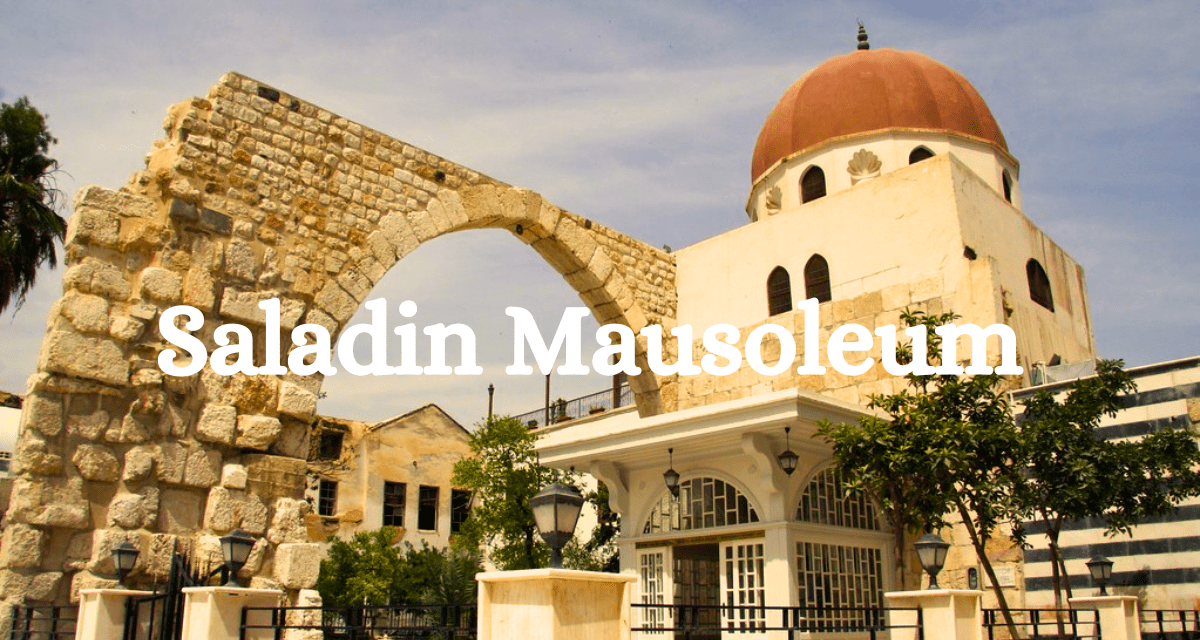All About Saladin Mausoleum, Damascus
The Saladin Mausoleum is a beautiful and historic place. It’s designed in a simple and elegant style, reflecting the modesty and humility of Saladin himself. Inside, there’s a tomb where Saladin’s remains are believed to rest. People from all over the world visit the Saladin Mausoleum to pay their respects to this great leader.
It’s not just a place for Muslims; people of all faiths and backgrounds come to learn about Saladin’s legacy and the important role he played in shaping the history of the Middle East.
The mausoleum stands as a reminder of Saladin’s leadership, his commitment to justice and tolerance, and his efforts to unite people of different cultures and backgrounds. It’s a symbol of calmness and harmony in a region often marked by conflict and division.
The mosque is really big, like a huge square measuring 515 by 330 feet (One Hundred fifty-seven by hundred meters). Inside, there’s a big open space called a courtyard, covered by a row of arches held up by thin columns.
On one side of the mosque is a special place for worship called a “liwan.” It’s like a long hallway divided into three parts by more columns and arches. In the middle of this area, there’s a part that sticks out with a dome on top. This dome used to be constructed of wood.
The walls on the south side of the mosque have windows covered with fancy designs made of marble. These designs are some of the earliest examples of fancy patterns in Islamic buildings. The walls of the mosque used to have beautiful pictures all over them, showing a made-up space that people thought looked like a paradise from the Quran. Sadly, most of these pictures are gone now, but some small pieces remain.
In 1401, The mosque went through a lot of troubles it was destroyed by Timur, then reconstructed by the Arabs. Later, in 1893, it was harmed by a fire. Afterward, there is no big reconstruction at Saladin Mausoleum.
Saladin Mausoleum: Saladin Death and Burial
Salah al-Din, also known as Saladin, passed away due to a fever in March 1193. Initially, he was laid to rest temporarily in the Damascus Citadel while preparations were made for his final resting place. During this time, construction began on his mausoleum. Near the mausoleum, a religious school was also built.
Construction of the Mausoleum
Saladin passed away in 1193 in Damascus, shortly after his triumph over the Crusaders. His mausoleum was built in 1196, three years after his death, near the Umayyad Mosque, a revered religious site. The initial structure was relatively modest, reflecting Saladin’s own humility, despite his achievements as a military leader.
Mausoleum of Saladin Architecture
The Tomb of Salah al-Din is a simple building with a square room and pretty walls made of different colors of stone. Inside, there are two tombs: one wooden and said to hold Saladin’s remains and one marble donated by Kaiser Wilhelm II. The room is small but decorated nicely with pictures and things to honor Saladin. His tomb, covered in special cloth with gold edges, is in the middle and stands out.
The Madhnat ul-‘Arus, also known as the Minaret of the Bride, is located near Saladin’s tomb in the courtyard of Masjid Umawi. You can also see some parts of the old school called Madrasah al-Aziziyah in the courtyard.
Historical Background of Saladin
Saladin was born in 1137 in Tikrit (modern-day Iraq) and rose to power as the first sultan of Egypt and Syria, founding the Ayyubid Dynasty. He is celebrated for uniting the Muslim world and successfully defending Islamic lands against the Crusaders. His capture of Jerusalem in 1187 and his chivalrous conduct during the Crusades made him a legendary figure in both the Muslim and Christian worlds.
Construction of the Mausoleum
Saladin passed away in 1193 in Damascus, shortly after his triumph over the Crusaders. His mausoleum was built in 1196, three years after his death, near the Umayyad Mosque, a revered religious site. The initial structure was relatively modest, reflecting Saladin’s own humility, despite his achievements as a military leader.
Saladin Mausoleum
Salahuddin Grave
Salahuddin Al-Ayyubi, also known as Saladin, was a famous Muslim leader known for his bravery and wisdom, especially during the Crusades. His grave is located in Damascus, Syria, in a small garden near the Umayyad Mosque. The tomb is simple yet respected, reflecting his humble nature.
Salahuddin is remembered for connecting Muslim forces and recapturing Jerusalem from the Crusaders in 1187, but he is also admired for his fairness and kindness toward his enemies. His grave has become a place where people visit to pay their respects to the great leader who left a continuing mark on history.
Also Read:
Frequently Ask Questions
Ques: Where was Saladin buried?
Ans: Saladin was buried near the northwest corner of the Great Umayyad Mosque in Damascus, Syria.
Ques: Was Saladin Sunni or Shia?
Ans: Saladin was Sunni.
Ques: What is Saladin most famous for?
Ans: Saladin is most famous for his role in the Crusades and the recapture of Jerusalem in 1187.
Ques: Where is Khalid bin Walid buried?
Ans: Khalid bin Walid is buried in Homs, Syria.
Ques: What city did Saladin free?
Ans: Saladin freed Jerusalem from Crusader control.
Ques: When did Saladin conquer Damascus?
Ans: Saladin conquered Damascus in 1174.
Ques: What story behind the Saladin Mausoleum?
Ans: Saladin’s Mausoleum is a historic site in Damascus, Syria, where the renowned Islamic leader, Saladin, is buried. Saladin was a respected military leader and sultan who played a significant role in the Crusades during the Middle Ages. His mausoleum was built in the 12th century by the Ayyubid dynasty, which he founded.
The mausoleum features beautiful architecture and is an important pilgrimage site for Muslims. It serves as a reminder of Saladin’s legacy and his assistance to Islamic history. Today, visitors can explore the mausoleum and learn about Saladin’s life and achievements.












One thought on “Saladin Mausoleum, Damascus: Know All About Tomb of Saladin”